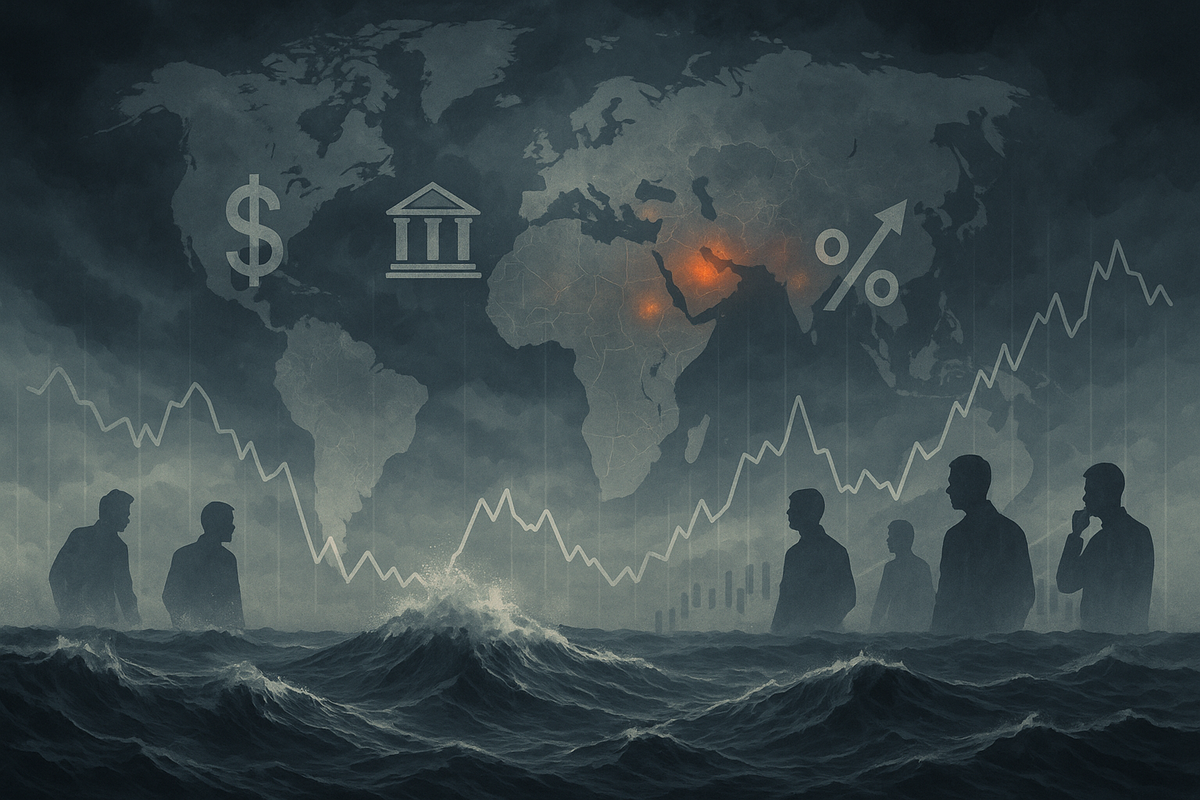
The global financial landscape is currently grappling with a potent cocktail of geopolitical uncertainties and persistent economic concerns, creating a highly volatile environment for investors. From escalating conflicts in the Middle East to the nuanced signals emanating from central banks, these interconnected factors are amplifying stock market fluctuations and compelling a fundamental shift in investor sentiment towards more cautious and adaptive approaches. This period of heightened risk is not merely a fleeting moment but a defining era that demands strategic re-evaluation and resilience from market participants.
This article delves into the intricate ways these broader geopolitical risks, particularly those stemming from the Middle East, are influencing market dynamics. It will explore how the delicate balance between central bank policies and incoming economic data is shaping investor confidence, leading to a more circumspect investment posture. Furthermore, we will examine the evolving strategies investors are deploying to navigate this complex terrain, including tactical positioning in rate-sensitive sectors, the increasing adoption of geopolitical hedges such as defense stocks, cybersecurity, and gold, and the inherent challenges posed by political rhetoric that threatens to interfere with monetary policy independence.
The Unfolding Tapestry of Risk: What Happened and Why It Matters
The current market turbulence is largely a direct consequence of a confluence of significant geopolitical events and underlying economic uncertainties. At the forefront are the ongoing conflicts and diplomatic tensions in the Middle East, which have historically served as a major source of global oil supply. Events such as the Israel-Hamas war and the more recent Israel-Iran tensions have immediately injected a "geopolitical premium" into energy markets, causing oil prices to surge due to fears of supply disruptions, particularly through critical routes like the Strait of Hormuz. This directly impacts industries sensitive to energy costs, such as transportation and manufacturing, potentially leading to reduced profitability and job losses.
Beyond the immediate energy market impact, these geopolitical shocks introduce profound uncertainty about future economic conditions and corporate profitability. Unlike typical market fluctuations, geopolitical events are challenging for investors to price due to their unique nature, rare occurrence, and unpredictable duration and scope. This leads to sharp, often negative, market reactions, with initial stock market responses frequently characterized by steep declines that can persist for days or weeks as the market attempts to process the risks. This heightened uncertainty also contributes to what is known as Economic Policy Uncertainty (EPU), which has been shown to significantly reduce stock returns, especially during periods of extreme volatility. Key players involved include national governments, central banks like the Federal Reserve, and, of course, the global investment community. While the immediate market reaction to Middle East conflicts often focuses on energy markets, the broader impact on U.S. stocks tends to be limited unless there is a significant escalation, though investor sentiment remains fragile.
Navigating the Crosscurrents: Winners and Losers in a Volatile Market
In this environment of elevated geopolitical risk and economic uncertainty, certain sectors and assets are emerging as relative winners, while others face significant headwinds. Investors are strategically reallocating capital to mitigate risk and capitalize on shifting market dynamics.
Among the clear beneficiaries are defense stocks. Heightened geopolitical tensions and increased global instability directly translate into greater demand for military readiness and defense spending. Companies such as Lockheed Martin (NYSE: LMT) and Huntington Ingalls Industries (NYSE: HII) have seen surges in their stock prices, serving as robust hedges during periods of increased geopolitical risk, notably during the Russia-Ukraine war. Similarly, the escalating threat of AI-driven cyberattacks has propelled cybersecurity firms into the spotlight as a crucial geopolitical hedge, with investors considering exposure to both established players and emerging AI-focused companies in this space. Gold, a perennial safe-haven asset, has also experienced renewed interest, with investors allocating a portion of their portfolios (e.g., 10-15% via ETFs or physical bullion) to hedge against systemic risks and politicized monetary policy. Central banks globally are also increasing their gold purchases, signaling a diversification away from U.S. dollar assets. Bonds also play a key role in defensive strategies, providing capital preservation and diversification, especially as a rate-cutting cycle approaches.
Conversely, several sectors and assets are facing challenges. Rate-sensitive sectors like utilities and real estate can initially suffer when central banks signal interest rate hikes, as borrowing becomes more expensive, impacting consumer spending and corporate costs. Industries heavily reliant on stable supply chains and those with significant exposure to energy costs, such as transportation and manufacturing, are vulnerable to disruptions and price spikes stemming from geopolitical conflicts. Furthermore, emerging market economies often experience a more pronounced and persistent negative impact from geopolitical events compared to developed markets. While the U.S. dollar has traditionally been a safe haven, its status has recently been noted as somewhat reduced, indicating a broader re-evaluation of traditional safe assets.
Industry Impact and Broader Implications: A Shifting Paradigm
The current confluence of geopolitical tensions and economic uncertainty is not merely causing short-term market fluctuations; it is instigating broader shifts across industries and prompting significant re-evaluations of long-term strategies. This environment is accelerating existing trends and introducing new complexities that will shape the global economy for years to come.
One significant implication is the intensified focus on supply chain resilience. Companies are increasingly scrutinizing their global supply networks, seeking to diversify sourcing and reduce reliance on single points of failure, particularly in regions prone to geopolitical instability. This could lead to a partial reversal of globalization trends, favoring more localized or regionalized production. The heightened demand for geopolitical hedges is also becoming a more ingrained industry trend, with asset managers and institutional investors systematically incorporating defense, cybersecurity, and gold into their portfolio construction. This reflects a recognition that geopolitical risk is no longer an outlier event but a persistent factor requiring dedicated hedging strategies.
Regulatory and policy implications are also significant. Governments are likely to continue increasing defense spending in response to perceived threats, benefiting the defense industry. There's also a renewed emphasis on energy security, potentially accelerating investments in domestic energy production and alternative energy sources to reduce reliance on volatile regions. Historically, while geopolitical events can cause significant short-term volatility, global financial markets often demonstrate resilience and recover over the longer term, provided underlying economic fundamentals remain intact. However, the current landscape is complicated by the growing challenge posed by political rhetoric and potential monetary policy interference. Openly challenging the independence of central banks, such as former President Trump's past criticisms of the Federal Reserve, creates profound uncertainty and can erode trust in the stability of financial institutions. If central banks are perceived to be succumbing to political influence, it could lead to fears of uncontrolled inflation and currency devaluation, deterring foreign investment and potentially destabilizing markets. This adds another layer of complexity for investors, who must now consider not only economic data and geopolitical events but also the political will to maintain monetary policy independence.
The Road Ahead: What Comes Next for Investors
As the global financial landscape continues to be shaped by geopolitical tensions and economic uncertainties, investors must remain agile and forward-looking. The immediate future suggests a continuation of market volatility and cautious sentiment, but also potential opportunities for those who can strategically adapt.
In the short term, we can anticipate continued flight to safety as investors seek refuge in traditional safe-haven assets like gold and high-quality bonds during periods of heightened risk. Market participants will be closely monitoring geopolitical developments, particularly in the Middle East, for any signs of escalation or de-escalation, which could trigger rapid market reactions. Central bank communications will also remain paramount, with every word scrutinized for clues about future interest rate paths and their commitment to balancing inflation control with economic growth. For investors, this means maintaining a long-term perspective and avoiding emotionally driven decisions during market dips.
Looking further ahead, the long-term possibilities suggest that markets can recover and even reach new highs, provided underlying economic fundamentals remain robust. However, the strategic pivots required from investors will be more pronounced. This includes a continued emphasis on diversification across asset classes and geographies to mitigate concentrated risks. Increased cash holdings may become a more common strategic allocation, allowing investors to seize opportunities during market downturns. Strategic positioning in rate-sensitive sectors will be crucial, with investors carefully evaluating when to enter or exit utilities, real estate, and financials based on anticipated interest rate cycles. The demand for geopolitical hedges will likely solidify as a permanent feature of portfolio construction. Potential scenarios range from a gradual stabilization of geopolitical tensions, allowing economic fundamentals to reassert themselves, to prolonged periods of uncertainty requiring sustained defensive strategies. The ongoing interplay between central bank independence and political influence will also be a critical factor to watch, as it could significantly impact the credibility of monetary policy and the stability of financial markets.
Conclusion: Navigating a New Era of Market Complexity
The current financial climate, characterized by the interplay of geopolitical tensions and economic uncertainty, represents a significant inflection point for investors. The amplified stock market volatility and the pervasive cautious sentiment underscore a fundamental shift in the investment paradigm, demanding a more nuanced and adaptive approach than ever before.
Key takeaways from this period include the undeniable impact of geopolitical events, particularly those in the Middle East, on global energy markets and broader economic stability. The delicate dance between central bank signals and incoming economic data continues to dictate investor sentiment, while the growing specter of political interference in monetary policy adds an unprecedented layer of complexity. Investors are no longer simply reacting to economic cycles; they are actively seeking to hedge against systemic geopolitical risks, leading to a surge in demand for assets like defense stocks, cybersecurity solutions, and gold.
Moving forward, the market will likely remain resilient but inherently complex. Success will hinge on an investor's ability to understand these interconnected factors and strategically position their portfolios. Diversification, a long-term perspective, and a willingness to adapt to evolving market conditions will be paramount. Investors should closely monitor central bank communications for shifts in monetary policy, pay keen attention to key economic data releases, and remain vigilant regarding geopolitical developments that could trigger sudden market movements. Furthermore, the ongoing discourse surrounding central bank independence and political rhetoric will be a critical watchpoint in the coming months, as it holds the potential to significantly influence market confidence and the stability of the financial system. This new era of market complexity demands not just financial acumen, but also a deep understanding of global affairs and political dynamics.




